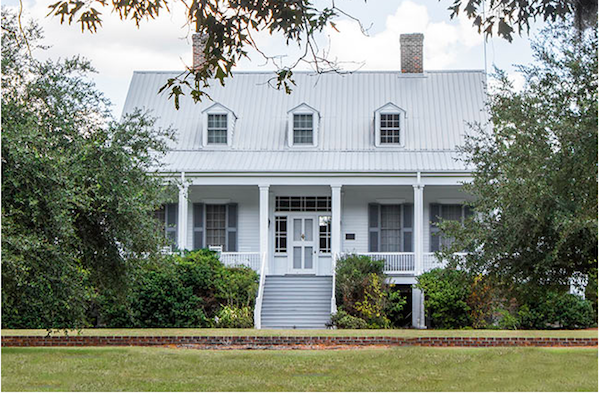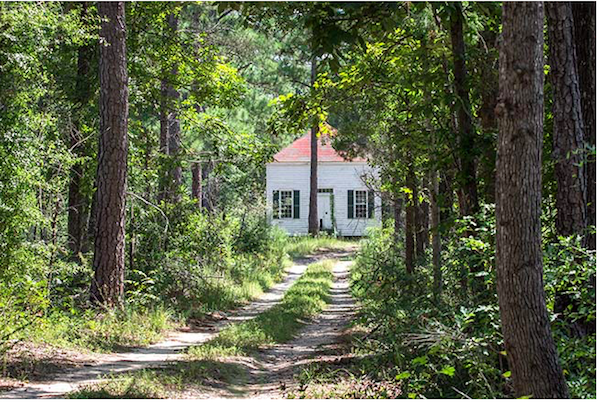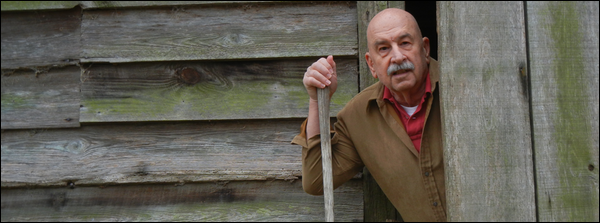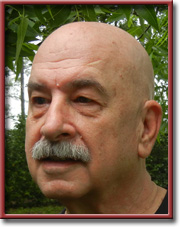The Supreme Adventure
“Ma Twiggs (was) absorbed in reading a seafaring adventure story as she walked to the summer bath house behind the big house, stepping into the bath, only to brush up against one of the watermelons left to cool in the bathwater. She is said to have leapt out of the bath and run, screaming, ‘Sea serpents! Sea serpents!’ at the top of her lungs all the way back to the house, stark naked.”—William A. Balk, Jr.
Epicurus’ Porch
By William A. Balk, Jr.

ELKO South Carolina—(Weekly Hubris)—June 2019—When the package arrived, unexpected, but carrying my cousin’s Kansas return address, I was anxious to open it to discover its mysterious contents. Pete and I had been “talking” via email recently and he had confirmed my mailing address, but I hadn’t really expected anything to be sent.
It was a padded mailer, the sort of thing one sends a book in. It’s not the usual thing for us to exchange books. Both of us are readers, although what we choose to read differs significantly.
I tend toward literary fiction and quirky non-fiction subjects like the history of textiles and garden design. Pete, I think, might prefer the more technical literature on IT design or the specifications for the meticulous restoration of his exquisite mid-century-modern automobiles—a gorgeous Buick convertible and an intimidatingly perfect Mustang, both of them his family’s cars, previous generations’ joy and delight.
I started to open the package, having brought the day’s mail in to my mother’s bedside. I try to carry on some of her old daily rituals, even though she is no longer able to discern precisely the meaning or purpose of these things. We go through her mail and discuss cards and letters, share a complaint about bills, decide whether to throw junk mail into the trash. I do the same thing with checks and paying bills. She can no longer understand all the steps needed to write a check, so I have for years assumed her financial duties with the aid of my siblings. But we still confirm that she wants to pay these bills, that she wants me to sign her check for her “this time,” that she still is vitally involved in these rituals of daily life.
Tearing open the package, both of us, Mama and I, were delighted to discover a book inside, but I was utterly unprepared for what Pete had sent. A hard-bound volume with a solid black cover, the title and author in white lettering, it announced The Supreme Adventure by Sarah Lowe Twiggs.
It was indeed a surprise, although I knew immediately what it was. Sarah Lowe Twiggs, the author of this volume, was my 95-year-old mother’s great-grandmother. She was “Ma Twiggs” in all the family’s stories about her for the last hundred years or more, and she had died in 1920, before my mother was born.
I remember growing up hearing stories about the family, tales sufficiently entertaining or bizarre that a listener might think they exaggerated just a little bit. The story of Big John’s being lost, feared killed, as a teenager in his bateau in a hurricane off St. Helena Island near Beaufort, found washed up and sheltering under an overturned boat days later. His rescuers all were supposedly convinced they had found his ghost. Stories of young Frank running away from home in Augusta, Georgia, hopping trains to become a cowboy out West. Ma Twiggs, absorbed in reading a seafaring adventure story as she walked to the summer bath house behind the big house, stepping into the bath, only to brush up against one of the watermelons left to cool in the bathwater. She is said to have leapt out of the bath and run, screaming, “Sea serpents! Sea serpents!” at the top of her lungs all the way back to the house, stark naked.
Mama didn’t remember who Sarah Lowe Twiggs was as we examined the book, but I certainly did. I’d been looking for her—well, looking for information about her life, her marriage, her interests . . . and, especially, her writing—for many years.
I knew—or, rather, I had been told—that Ma Twiggs had married my great-great-grandfather, Joseph Erwin; borne their two children, a daughter and a son; and then, later, become determined to marry off her daughter, Lila, my great-grandmother, to a much older, wealthy gentleman. Stories about Ma Twiggs almost always include descriptions of her intellectual pursuits, her independence, her very strong will, and a mention of her literary work, which was said to have brought her some fame.
Family stories often prove hard to verify, and the older the stories are, the greater the challenge to discover the facts. This had proved to be the case with my fascination with learning about Ma Twiggs, and years of inquiry and some persistent research had left me still uninformed about the details of her life and personality—and utterly frustrated in my quest to find any of her writing.
First of all, there was the matter of her name. She was always—always! —referred to as Ma Twiggs, Mrs. Twiggs, or Sarah Lowe Twiggs. Never—never! —as Mrs. Erwin.
While Joseph Erwin, her husband, spent his entire life, apparently, in Barnwell County, South Carolina, Ma Twiggs was entirely identified with Augusta, Georgia, where she lived with her daughter Lila before and after Lila’s marriage, and until Ma Twiggs died.
Had the then Miss Twiggs actually married Mr. Erwin? Had there been a marriage and a (shocking!) divorce? What in the world was the story?
But always there was the account of Ma Twiggs and her writing. Although my search for anything written by her had begun long before there was an internet, once I was able to use the computer in my searches, I began to uncover some evidence.
There were some references in late 19th Century and early 20th Century “Who’s Who” books which included Ma Twiggs and which mentioned her celebrated epic poem, “The Supreme Adventure.”
Now having a title, I began searching for a copy of the poem—only to be frustrated again for years, finding nothing. I remember several years ago, as my cousin Pete and I were talking over the kitchen table about his genealogical research and some of the old family papers each of us had archived, I mentioned to Pete my years-long search for Ma Twiggs’s poem.
Pete took on a pensive look, then said, “I think there may be a copy of that in one of the boxes from my mother’s storage. When I get back, I’ll try to find it.”
Well! Now, I thought, we’re getting somewhere!
Oddly enough, it was just about this time that various copies of the original The Supreme Adventure had appeared in old collections. With new technologies now available for inexpensive reprinting of facsimile editions, and with copyright issues not applicable in this case, several small specialty presses had undertaken to bring the book back into print as a “scholarly service.”
To my great pleasure, Pete had discovered this fact and had sent me a copy of one of these new printings. And now I have read it.
I can say with reasonable certainty that very few others need bother to read it. It is, as I said, an epic poem, one covering a lot of territory, both in its thematic concerns and in the amount of paper consumed in its printing. The language is, as one might expect, self-consciously poetic and Victorian.
It is an eschatological poem, concerned with the afterlife and the intersection between those in the afterlife with those others of us yet to face death. The theological themes vary in some significant ways from the usual understandings taught by scholars of mainstream Christian thought, but they still fit within the broader traditions of Christian teaching.
I’m no theologian, however, and there’s only so far I can delve into that discipline before I feel the need of a dirty joke. What does interest me, however, is the insight that the poem, its philosophy, its original publication details, all offer in understanding Ma Twiggs.
The book was published in 1919, the First World War having ended months before. Its publisher was the Academy Book Room of Bryn Athyn, Pennsylvania which is affiliated with the New Church, one of the branches of the Swedenborgian Church, a small, fascinating denomination which sprang from Lutheranism in the 18th Century. Ma Twiggs, surprisingly, I learned, was a follower of Swedenborg.
Despite the noted devotion of their contemporaries to standard Baptist, Presbyterian, and Methodist practice at the time, I’ve found interesting divergences in religious practice among these family members in the 19th Century. Most famously, perhaps, is the excommunication of several of the Erwin clan from their community’s Kirkland Baptist church, after having worshipped and taken communion with other family members at their (also Baptist) church! This was heterodoxy, and the family was expelled from their home church; then formed the Antioch Christian Church.

Several years later, in 1838, the famous reform evangelist, Alexander Campbell, wrote of his visit with the Erwins, his address to the Kirkland church, and the movement for reform in the church . . . all in the year (or decade, depending on who Ma Twiggs was talking to) before Sarah Lowe Twiggs was born in the Erwinton Community.
The Civil War and 30 years would pass before her eventual marriage to Joseph Erwin in 1870, a marriage which appears to have been poisoned fairly early by as yet unidentified forces. She bore two children with Joseph and, by 1880 was living either with her parents or on her own in nearby Augusta, Georgia.
When did Ma Twiggs connect with Swedenborgianism? I did find that one of the early leaders of the Swedenborgian New Church was a Georgia native, a popular novelist named Louis Pendleton. Pendleton wrote the Introduction for The Supreme Adventure.
What caused the calamitous breakdown in Ma Twiggs’s marriage? At various times in her life, she claimed (inaccurately!) to be a widow and, on one or two occasions, she is recorded as “divorced,” a description I have been told was almost unthinkable for a woman of her name and station.
How could the urgent need to marry off her young daughter Lila, whose affectionate name among family and friends was “Beauty,” result in a remarkably successful household of five children and an apparently very happy marriage?
And, in the bizarre and fascinating way that history and fable often work, Cousin Pete has just shown me that, by the 1880 census, Ma Twiggs—my maternal great-, great-grandmother—was living on Telfair Street in Augusta, two doors down from C. J. T. Balk, my paternal great-grandfather. The fates are intervening in this story, it seems, to bring my two parents together in the next century.
Genealogists often appear to worship the line of DNA descent. Instead, I’m using up all my OCD cred on a pursuit of narrative line. More details! Dangling story lines! Underdeveloped characters!
There’s so much left to find out. I’ve got to get back to work!
![]()
Note: The photographs of the Erwin House and of the Antioch Church were made by Brandon Coffey of the South Carolina Picture Project (https://www.scpictureproject.org). They are used here with his kind and generous permission.


3 Comments
judy pearce
Where is/was Erwinton? And do keep digging. I adore hanky panky among the ancestral sheets!
Will
Hanky panky galore in the family annals, Judy! And more tantalizing ‘questions’ lurking everywhere . . . and right now, I’m just focussing on this 19th-Century story around Ma Twiggs. You KNOW there’re skeletons (oh! that’s another family story! Skeletons! it’s about the house at the top of the piece above!) in nearly every room, and there’s centuries of family closets to go through.
Yes, there is an Erwinton, a few miles from Allendale, near the Savannah River. It’s named, obviously, for this part of the family. This area is still called Erwinton, and lies very near where Highway 301 crosses the Savannah River into Georgia.
Jane Miller
Isn’t this fun!! Hope you find a lot more irresistible tales. By the way, the Erwin House looks identically built to the Balk House in Elko!!